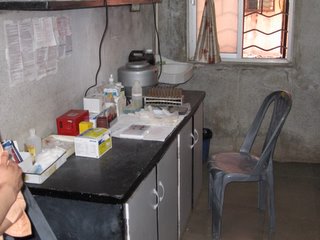
I didn’t think much about all the commotion in the hallway when I walked the halls of V.N. Desai, a municipal general hospital. People always abound waiting for their ten minutes with the doctors. I didn’t think anything of the police guards posted at the entrance to the hospital and intermittently throughout the building. Most hospitals have some form of security and they seemed in place, as if their brown khaki uniforms made them fit in, almost match with the color of the building. It wasn’t until we returned home for lunch that we learned from the other students that problems broke out at another hospital.
Two of my companions were sent to another municipal general hospital, one which I had already visited weeks ago, only to return to the guest house due to a strike. It seems a patient accosted and struck a doctor there and in reaction the doctors went on strike. I’m not too familiar with how strikes go down here in India. I hear they occur often. It does seem a bit awkward to hear of doctors on strike though. How long it will last and how things run at a hospital without them is a mystery to me. We returned to V.N. Desai the next day and heard they were on strike as well. There was an obvious decrease in patients hanging around but it seemed the staff was working as per usual. Today, with the strike still in effect and growing to the other hospitals, we all went to different, private clinics. On the table lay the newspaper with its explanation.
The trouble began when Sumitra Walalvalkear (75), admitted on Wednesday
with respiratory and cardiac problems, died on Sunday afternoon.
When the doctor in charge, Dr. Rohan Inchwar, told daughter Chandrakala
that he did not know the cause of death and suggested a post-mortem, she
slapped him.
This is the second such case of violence at KEM this month. An FIR was
lodged at the Bhoiwada police station and, at 2 am, all doctors went on
strike. .
.
Currently, 2,500 doctors from 10 major hospitals—KEM, Bhabha,
Sion Hospital, B Y L Nair, Cooper, J J, St George, GT, Cama and Thane
Municipal Corporation Hospitals—have joined the strike.
Doctors at Bandra’s K B Bhabha Hospital went on strike after a similar
incident on Monday.
Heena Shaikh was admitted at 3 am with labour pains. Soon after, her
aunt Yasmin Sheikh entered the Labour Ward with her shoes on.
When the two doctors on duty, Dr Rujuta Bajaj and Dr Neepa Parikh,
stopped her, she slapped them. By 8 am, 65 doctors at
the hospital had gone on strike.
-Mumbai Newsline, Tuesday Feb. 28, front page
According to the same paper the demands of the doctors include among other things, 24-hour security, strict visiting hours for patient’s relatives, increase in stipend and non-bailable warrants for those guilty of violence against doctors.
 Before anyone starts worrying about safety conditions for us foreigners while we rotate through these hospitals, I just want to say don’t. Since the strike started we’ve adapted our daily plans. Even when we are in the municipal hospitals the situation is safe and we are nowhere near confrontational situations. The staff doesn’t want us to see such things, although I’m sure the more adventuresome people of the group would want to, and we’re not the target of hostility. It is a fascinating insight into the labor aspect of healthcare here. I couldn’t imagine a strike held by doctors. Sure, nurses can keep things running for the most part, especially in the wards with interned patients. They do most of the patient care at that point anyway. But, with a strike enacted who wants to go to the hospital? If for us it is an inconvenience to our internship, imagine those with pressing needs. And to think it started because of shoes.
Before anyone starts worrying about safety conditions for us foreigners while we rotate through these hospitals, I just want to say don’t. Since the strike started we’ve adapted our daily plans. Even when we are in the municipal hospitals the situation is safe and we are nowhere near confrontational situations. The staff doesn’t want us to see such things, although I’m sure the more adventuresome people of the group would want to, and we’re not the target of hostility. It is a fascinating insight into the labor aspect of healthcare here. I couldn’t imagine a strike held by doctors. Sure, nurses can keep things running for the most part, especially in the wards with interned patients. They do most of the patient care at that point anyway. But, with a strike enacted who wants to go to the hospital? If for us it is an inconvenience to our internship, imagine those with pressing needs. And to think it started because of shoes.Shoes are always removed before entering certain sectors of hospitals, including operating rooms and labor wards. Even in the few private clinics we’ve visited shoes are ceremonially removed before passing the threshold between waiting lobby and examination room. With the streets being as they are, it makes this foreign practice almost understandable. You can easily imagine the monsoons as the only thing with the capability to clean this city. Even with your shoes freshly dusted from the outside streets, it’s still awkward to walk around these areas in your socks or the sandals randomly provided.


0 Comments:
Post a Comment
<< Home